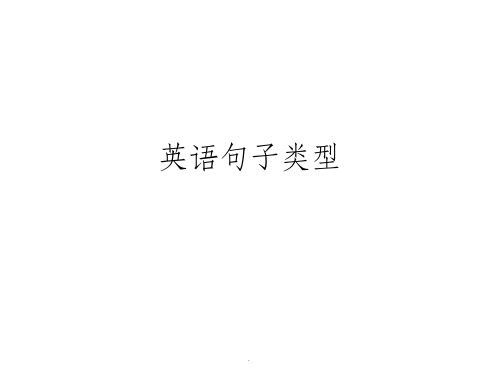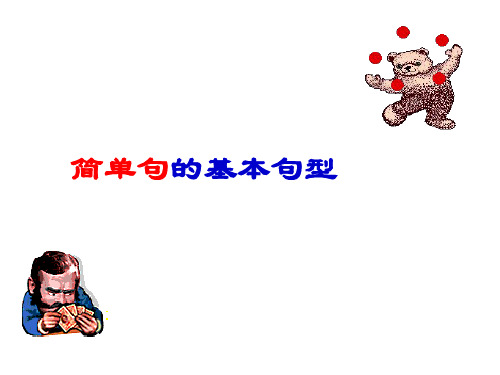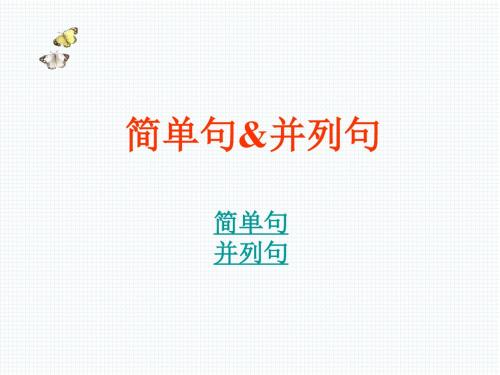英语简单句课件
合集下载
人教版 高中英语必修一简单句的写作课件(13张ppt)

佟大为妻子产下一女
如何断句
核心:抓谓语
不及物动词 1. 主谓
1 实义动词
及物动词 2. 主谓宾
3. 主谓宾宾
2 系动词 5. 主系表
4. 主谓宾 宾补
3 助动词 +实义动词=谓语动词
茶道
中国的茶起源于周朝 中国的茶繁荣于唐朝和宋朝
茶道
1. 主谓
中国的茶起源于周朝。 Chinese tea originated in Zhou dynasty.
茶道
3. 主谓宾宾
我将告诉你茶的分类。 I will tell you the classification of tea.
人们经常送绿茶给朋友。 People often give friends green tea.
茶道
4.主谓宾宾补
乌龙茶可以让你瘦身。 Oolong tea makes you thin.
写写 简作 单之 句如
何
断句的重要性
有一天,孙悟空一觉睡醒,发现自己 的金箍棒不见了。跑回花果山找,没找见。 这时候,大马猴说,大王,要不咱把土地 叫出来问问?孙悟空一听,有道理,就赶
忙叫土地公公出来,“土地老儿,你看我
金箍棒在哪?”土地公公颤巍巍的抬头看 道“大圣,您的金箍棒就棒在特别配你的
头型”。
picking herbs.
只在此山中,The teacher was in this mountain. 云深不知处。The cloud was so thick that I didn’t know
where the teacher was.
寻隐者不遇
我 松下问童子, 童子 言师采药去。 隐者 只在此山中,
云深我不知 隐者处。
如何断句
核心:抓谓语
不及物动词 1. 主谓
1 实义动词
及物动词 2. 主谓宾
3. 主谓宾宾
2 系动词 5. 主系表
4. 主谓宾 宾补
3 助动词 +实义动词=谓语动词
茶道
中国的茶起源于周朝 中国的茶繁荣于唐朝和宋朝
茶道
1. 主谓
中国的茶起源于周朝。 Chinese tea originated in Zhou dynasty.
茶道
3. 主谓宾宾
我将告诉你茶的分类。 I will tell you the classification of tea.
人们经常送绿茶给朋友。 People often give friends green tea.
茶道
4.主谓宾宾补
乌龙茶可以让你瘦身。 Oolong tea makes you thin.
写写 简作 单之 句如
何
断句的重要性
有一天,孙悟空一觉睡醒,发现自己 的金箍棒不见了。跑回花果山找,没找见。 这时候,大马猴说,大王,要不咱把土地 叫出来问问?孙悟空一听,有道理,就赶
忙叫土地公公出来,“土地老儿,你看我
金箍棒在哪?”土地公公颤巍巍的抬头看 道“大圣,您的金箍棒就棒在特别配你的
头型”。
picking herbs.
只在此山中,The teacher was in this mountain. 云深不知处。The cloud was so thick that I didn’t know
where the teacher was.
寻隐者不遇
我 松下问童子, 童子 言师采药去。 隐者 只在此山中,
云深我不知 隐者处。
英语句子类型(简单句、并列句、复合句)ppt课件

• ①He helps me and he also helps others. • ②She not only gave us a lot of advice, but also
helped us to overcome difficulties. • 2.表示转折关系,常用连词有but,however, yet(然
而),while(而)等。 • ①He is young, but he works hard. • ②She is tall, while her elder sister is short.
.
并列句
• 3.表示选择关系,常见连词有or,not...but(不是…… 而是……),either...or...(要么……要么……)等。
关系词whose实际上是先行词的所有格
4.The school where I study is far from my home.
I
bought
a hat
yesterday.
The children ran
home.
We
ate
our meal
in silence.
The car
stopped
suddenly.
.
并列句
• 由并列连词把两个或两个以上的简单句连接起来的句子叫 并列句。常见分类:
• 1.表示同等、平行或承接关系,常用连词有and, both...and...,not only...but also..., neither...nor...,as well as等。
The teacher asked me to read the passage. 6. There be句型:
There is a book on the desk. There existed many dinosaurs.
helped us to overcome difficulties. • 2.表示转折关系,常用连词有but,however, yet(然
而),while(而)等。 • ①He is young, but he works hard. • ②She is tall, while her elder sister is short.
.
并列句
• 3.表示选择关系,常见连词有or,not...but(不是…… 而是……),either...or...(要么……要么……)等。
关系词whose实际上是先行词的所有格
4.The school where I study is far from my home.
I
bought
a hat
yesterday.
The children ran
home.
We
ate
our meal
in silence.
The car
stopped
suddenly.
.
并列句
• 由并列连词把两个或两个以上的简单句连接起来的句子叫 并列句。常见分类:
• 1.表示同等、平行或承接关系,常用连词有and, both...and...,not only...but also..., neither...nor...,as well as等。
The teacher asked me to read the passage. 6. There be句型:
There is a book on the desk. There existed many dinosaurs.
英语基础语法讲解简单句PPT课件

• Her father bought her a dictionary as a birthday present.她爸爸 给她买了一本词典作为生日礼物。
• The old man always tells the children stories about the heroes in the Long March.老人经常给孩子们讲述长征途中那些英雄的故事。
句子结构
结构特征
举例
简单句 只有一个主谓结构
I love you.
并列句 简单句+并列连词+简单句 I love you and you love me.
复合句
简单句(主)+关系连词+ I will marry you if you love me
简单句(从)
enough.
关系连词+简单句(从)+
简单句(主)
第21页/共26页
练习——翻译句子
• 1.他把照片寄给了我。 • 2.读书会给我们带来很多乐趣。 • 3.Can you give me your phone number? • 4.Pass me that book, please. • 5.Lily hands me a picture.
第22页/共26页
接宾语
l will do everything for you.
第5页/共26页
基本句型一:主+谓
• 主语加不及物谓语动词组成,表示主语的动作。 • E.g. Things change.
•
主
谓(vi)
•
Time flies.
•
主
谓(vi)
第6页/共26页
练习——翻译以下句子
• The old man always tells the children stories about the heroes in the Long March.老人经常给孩子们讲述长征途中那些英雄的故事。
句子结构
结构特征
举例
简单句 只有一个主谓结构
I love you.
并列句 简单句+并列连词+简单句 I love you and you love me.
复合句
简单句(主)+关系连词+ I will marry you if you love me
简单句(从)
enough.
关系连词+简单句(从)+
简单句(主)
第21页/共26页
练习——翻译句子
• 1.他把照片寄给了我。 • 2.读书会给我们带来很多乐趣。 • 3.Can you give me your phone number? • 4.Pass me that book, please. • 5.Lily hands me a picture.
第22页/共26页
接宾语
l will do everything for you.
第5页/共26页
基本句型一:主+谓
• 主语加不及物谓语动词组成,表示主语的动作。 • E.g. Things change.
•
主
谓(vi)
•
Time flies.
•
主
谓(vi)
第6页/共26页
练习——翻译以下句子
英语简单句的五种基本句型 课件-高中英语(共23张PPT)

8.主语+系动词+形容词+介词短语 She is fond of this country. I was sick of lying in bed. They seem delighted with the result.
9.主语+系动词+形容词+不定式 I’m happy to meet you. She was eager to see her people.
real world; rock music makes
people think abut the world
and how to make their life
better.
主谓宾宾补
祈使句的主语一般都省略掉
一 主语+不及物动词
1.主语+不及物动词 The sun is rising. It’s snowing. It rained yesterday
2.主语+不及物动词+状语 Did you sleep well? She often dreams. You go first and I will follow behind.
5.They kept their marriage a
secret. 主谓双宾
6.He played dead. 主谓
7.She was nicknamed “Little
Rabbit”. 主谓宾
8.Show
me
what
you
bought.
主谓 双宾
9.She never doubted that she
1.主语+及物动词+宾语+形容词 I thought her so nice and sincere. They didn’t believe such a thing possible. He fo.
高考英语简单句基本句型课件

4. My brother and I go to school at half past seven in the morning and come back home at five in the afternoon. (并列主语和并列谓语)
Noun / Pronoun / the + adj
summer course to improve my writing
skills.
A. for me taking
B. me taking
C. for me to take
D. me to take
2. -Is Bob still performing?
-I’m afraid not. He is said______ the
etc.
Noun/ Pronoun/ adj. / adv./ Infinitive/ V-ing / V-ed/
go / come / remain/ keep
clause
taste / smell etc.
etc.
1.主语+系动词+表语( S+Link.V+P ), 说明主语的特征、类属、状态、身份。
B. were sent
C. had sent
D. had been sent
2. The hero’s story______ differently in the newspaper. A. was reported B. was reporting C. reports D. reported
5. The lightsΛ still on. are 6. All the potatoes changed bad. went
Noun / Pronoun / the + adj
summer course to improve my writing
skills.
A. for me taking
B. me taking
C. for me to take
D. me to take
2. -Is Bob still performing?
-I’m afraid not. He is said______ the
etc.
Noun/ Pronoun/ adj. / adv./ Infinitive/ V-ing / V-ed/
go / come / remain/ keep
clause
taste / smell etc.
etc.
1.主语+系动词+表语( S+Link.V+P ), 说明主语的特征、类属、状态、身份。
B. were sent
C. had sent
D. had been sent
2. The hero’s story______ differently in the newspaper. A. was reported B. was reporting C. reports D. reported
5. The lightsΛ still on. are 6. All the potatoes changed bad. went
简单句五大基本句型课件(共36张)

eturn/ hand 加for: buy/ choose/ draw/ make/ order/ paint/ sing/ save
双宾语结构中有两个宾语,判断标准是 可否将两个宾语顺序替换并加介词to/for
1 I feel excited. 主语+ 谓语(系动词) + 表语 2 They are watching TV. 主语+谓语(及)+宾语 3 Many boys are running. 主语+谓语(不及物) 4 He gave Tom a present. 主 +谓 + 间宾+直宾句型 5 I find it interesting. 主 +谓 + 宾+宾补 6 Music sounds beautiful.主语+ 谓语(系动词) + 表语 7 I am a student. 主语+ 谓语(系动词) + 表语 8 She bought a pen for me主. +谓 + 间宾+直宾句型
英语中千变万化的句子归根结底都是由简单句的五 种基本句型组合、扩展、变化而来的,只要把这些基 本句型弄清楚,你就会游刃有余了
→1. S + V 主语+谓语 主谓结构
Vi 不及物动词
1.A golden eagle is flying. 后面没有宾语 2.A crane eats fish.
3.A Swan has
know/find
→1. S + V(lv) + P 主语+ 谓语(系动词) + 表语
be (am is are was were) / seem / keep /…是/好象(似 乎)是/保持
双宾语结构中有两个宾语,判断标准是 可否将两个宾语顺序替换并加介词to/for
1 I feel excited. 主语+ 谓语(系动词) + 表语 2 They are watching TV. 主语+谓语(及)+宾语 3 Many boys are running. 主语+谓语(不及物) 4 He gave Tom a present. 主 +谓 + 间宾+直宾句型 5 I find it interesting. 主 +谓 + 宾+宾补 6 Music sounds beautiful.主语+ 谓语(系动词) + 表语 7 I am a student. 主语+ 谓语(系动词) + 表语 8 She bought a pen for me主. +谓 + 间宾+直宾句型
英语中千变万化的句子归根结底都是由简单句的五 种基本句型组合、扩展、变化而来的,只要把这些基 本句型弄清楚,你就会游刃有余了
→1. S + V 主语+谓语 主谓结构
Vi 不及物动词
1.A golden eagle is flying. 后面没有宾语 2.A crane eats fish.
3.A Swan has
know/find
→1. S + V(lv) + P 主语+ 谓语(系动词) + 表语
be (am is are was were) / seem / keep /…是/好象(似 乎)是/保持
英语简单句的五个基本句型精品PPT课件

4.表持续的系动词。如___re_m__a_in____,____k_e_e_p___, ___s_t_a_y____,stand,rest,lie,hold等。
5.可带名词作表语的系动词。如be,__b_e_c_o_m__e_, ____s_o_u_n_d__,prove,remain,turn(该词后接的单数名 词前多不用冠词。如:He turned teacher.)等。
my heart into my study.我失败的原因在于我没 有全心全意学习。(表语从句)
句型1:主语+系动词+表语 1.我今天身体不太好。 I am not quite well today./ I feel bad today.
2.我希望你的梦想能成真。 I hope that your dream can come true. My wish is that your dream can come true.
His joke made all of us laugh. 注:其他各种句子都可由这些基本句型扩展、 变化或省略而构成。
基本句型一:主语+系动词+表语
该句型中,谓语动词不能表达一个完整的意思,必须加上 一个表明主语身份或状态的表语构成复合谓语,才能表 达完整的意思。这类动词叫做连系动词。
一)系动词有:
二):作表语的有名词、形容词、介词短语等。如:
1. He is a boy.他是一个男孩。( 名词 ) 2. The book is hers.这本书是他的。(名词性物主
代词) 3. He is tall.他个子高。( 形容词 ) 4. John is in good health.他身体健康。(介词短语) 5. We were excited at the good news.听到这个
5.可带名词作表语的系动词。如be,__b_e_c_o_m__e_, ____s_o_u_n_d__,prove,remain,turn(该词后接的单数名 词前多不用冠词。如:He turned teacher.)等。
my heart into my study.我失败的原因在于我没 有全心全意学习。(表语从句)
句型1:主语+系动词+表语 1.我今天身体不太好。 I am not quite well today./ I feel bad today.
2.我希望你的梦想能成真。 I hope that your dream can come true. My wish is that your dream can come true.
His joke made all of us laugh. 注:其他各种句子都可由这些基本句型扩展、 变化或省略而构成。
基本句型一:主语+系动词+表语
该句型中,谓语动词不能表达一个完整的意思,必须加上 一个表明主语身份或状态的表语构成复合谓语,才能表 达完整的意思。这类动词叫做连系动词。
一)系动词有:
二):作表语的有名词、形容词、介词短语等。如:
1. He is a boy.他是一个男孩。( 名词 ) 2. The book is hers.这本书是他的。(名词性物主
代词) 3. He is tall.他个子高。( 形容词 ) 4. John is in good health.他身体健康。(介词短语) 5. We were excited at the good news.听到这个
语法复习-简单句—初中英语课件ppt

A. is
B. are
C. was
D. were
(A
) 3. There _________ a temple at the top of the
mountain long long ago.
A. used to be
B. will be
C. were
D. is
( B ) 4. —_________ there any flowers in your garden?
桌面上有一本书和两支笔。
考点精讲精练
There are (were) two pens and a book on the desk. (two pens与be动词最近,故用are / were)
桌面上有两支笔和一本书。 There used to be a big house in front of the mountain. 在山的前面曾经有一座大屋。 There will be more trees in the garden in a short time. 很快这个花园就会有更多的树。
A. Never
B. Not
C. Doesn’t
D. No
(B
) 3. _________ me a message on WeChat before
you come to Guangzhou. I will meet you at the
airport.
A. Don’t send
B. Send
C. Sending
考点精讲精练
Anna wasn’t writing a letter at 8:00 last night, was she? 安娜昨晚8点时不在写信,是不是? (前句助动词是wasn’t (be), 后句用相应的was) You often go to the park to take a walk, don’t you? 你常常去公园散步,是不是? (前句动词是go(实义动词),后句用相应的don’t)
初中英语语法教学课件--简单句-并列句课件(共19张PPT)

3).表选择关系: or, either...or...,not...but...,or else(否则) Take the chance , or else you will regret it.
4).表因果关系:与for, so,then, 等连用。 I'd better take an umbrella, for it is going to rain.
he do so. 并列句
Step 4: 感叹句
What 修饰n What + a/an + adj.+ 单数+ 主谓! What+ adj.+ 复数/ 不可数+ 主谓!
How 修饰adj. /adv How+ adj./adv+ a/an+单数+ 主谓! How+ adj./adv. + 主谓!
简单句&并列句
简单句 并列句
简单句的五种基本结构。 1.主语+谓语 2.主语+系动词+表语 3.主语+谓语+宾语 4.主语+谓语+间接宾语+直接宾语 5.主语+谓语+宾语+宾补
step1: Warming up&Lead in
1)A bear comes.
主语 谓语
2)The woman with gold clothes is cool.
4. 并列句的更多表达:
1).表并列关系: 由and,both...and,not only...but (also), neither...nor等组成。 She not only sings but also dances.
2).表转折关系:与but, yet,while,still等连用。 The film is not perfect, yet, it's good.
4).表因果关系:与for, so,then, 等连用。 I'd better take an umbrella, for it is going to rain.
he do so. 并列句
Step 4: 感叹句
What 修饰n What + a/an + adj.+ 单数+ 主谓! What+ adj.+ 复数/ 不可数+ 主谓!
How 修饰adj. /adv How+ adj./adv+ a/an+单数+ 主谓! How+ adj./adv. + 主谓!
简单句&并列句
简单句 并列句
简单句的五种基本结构。 1.主语+谓语 2.主语+系动词+表语 3.主语+谓语+宾语 4.主语+谓语+间接宾语+直接宾语 5.主语+谓语+宾语+宾补
step1: Warming up&Lead in
1)A bear comes.
主语 谓语
2)The woman with gold clothes is cool.
4. 并列句的更多表达:
1).表并列关系: 由and,both...and,not only...but (also), neither...nor等组成。 She not only sings but also dances.
2).表转折关系:与but, yet,while,still等连用。 The film is not perfect, yet, it's good.
英语简单句_精品课件

pass the exam.
翻译下列句子: 1)她喜欢集邮.
She is fond of collecting stamps. 2)食物很精美,但他却没什么胃口.
The food was good, but he had little appetite.
3)我们到达电影院的时候,电影已经开演了. The film had begun when we got to the cinema.
1. You are sitting on the train home. 主+谓(S+V) 2. There comes the bus ! 主+谓(S+V) 3. The ego’s potential for expansion is limitless.
主+系 +表(S+V+P)
4. Breckenridge hosts the international Snow Sculpture Championships. 主+动 +宾(SVO)
分类
简 单 句
说明
例句
由一个主语或并列主
语和一个谓语或并列 1. Tom and I found her there. 谓语构成的句子。即 2. We all breathe, eat and work. 一套主谓关系。
由并列连词
1. He likes eggs, but he doesn’t
并 (and,so,but, or等) like chickens.
5. Our neighbors gave us a baby bird yesterday.
主+动 +间宾 +直宾(SVOiOd)
英语简单句五大基本句型 ppt课件

3. She finished her homework. A. 她完成了家庭作业。
不是啦,这样摆也无所谓!
B. 她把家庭作业完成了。 C. 家庭作业,她完成了。
中文句子词语摆放位置较随意 英语的句子词语摆放位置更固定
回头看看刚才三句话:
1. 学英语很重要。 2.今天天气好。 3.She finished her homework.
5.I like spring.
What order?
1.Spring is coming. 2. The weather turns warm. 3.I see birds flying in the sky.
4.Spring brings me so much happiness. 5.I like spring.
我们发现:
中文
谓语动词 可以没有谓语动词
To study English is very important. It is fine today. A. 她完成了家庭作业 B. 她把家庭作业完成了 C. 家庭作业,她完成了。
英文
必须有谓语动词
语序
词语摆放位位置置较较随随意意 词语摆放位置更固定
归纳为一句话,就是: 英语是以动词为核心,有固定语序的语言
我们发现:
中文
谓语动词
语序
To study English is very important. It is fine today. A. 她完成了家庭作业 B. 她把家庭作业完成了 C. 家庭作业,她完成了。
英文
ห้องสมุดไป่ตู้
1. 学英语很重要。 2.今天天气好。 3.She finished her homework.
2023年中考英语复习简单句课件(共28张PPT)

• hong kong is not very cold in winter冬天,香港不太冷
• 五种基本句型
• 1.主语+谓语 • I listen carefully. 2.主语+谓语+宾语 I kicked the ball. • 3.主语+系动词+表语 • The apple tastes good. • 4.主语+谓语+直接宾语+间接宾语 • She passed me some salt. • 5.主语+谓语+宾语+宾补 • My mother wants me to drink the milk.
• 三、There be 句型(也叫存现句) • 1“There is/are+某物/某人+某地/某时”结构表示“某地或某时有某物或 • 某人”。 • 如:There are two glasses of water on the table桌子上有两杯水。
• There is a good movie on TV tonight.今天晚上在电视上有一部好电影
let her not cry.
• There are more than fifty classes in yourschool,__________?
• There are few people in the classroom, _________?
• (3)陈述部分是祈使句,反意疑问部分用 will you。 • Take care of your children,will you? • Open the door,_____________?
• He seldom goes to the cinema, does he?
• 五种基本句型
• 1.主语+谓语 • I listen carefully. 2.主语+谓语+宾语 I kicked the ball. • 3.主语+系动词+表语 • The apple tastes good. • 4.主语+谓语+直接宾语+间接宾语 • She passed me some salt. • 5.主语+谓语+宾语+宾补 • My mother wants me to drink the milk.
• 三、There be 句型(也叫存现句) • 1“There is/are+某物/某人+某地/某时”结构表示“某地或某时有某物或 • 某人”。 • 如:There are two glasses of water on the table桌子上有两杯水。
• There is a good movie on TV tonight.今天晚上在电视上有一部好电影
let her not cry.
• There are more than fifty classes in yourschool,__________?
• There are few people in the classroom, _________?
• (3)陈述部分是祈使句,反意疑问部分用 will you。 • Take care of your children,will you? • Open the door,_____________?
• He seldom goes to the cinema, does he?
英语复习课件(人教):简单句陈述句、疑问句、反意疑问句、感叹句、祈使句、倒装句(共20张PPT)

考点三 反意疑问句
反意疑问句的构成: 陈述句+附加疑问句?附加疑问句的 否定式必须缩写。
1.陈述句部分与附加疑问句部分意思相反: 前肯后否、 前否后肯。
Mary is a teacher, ___is_n_'_t_s_h_e_? He didn't tell you the story, ___d_id__h_e___? 2.反意疑问句的基本对应形式如下: (1)be动词对应be动词。如: She is a policewoman, __i_sn__'t_s_h_e__? (2)情态动词对应情态动词。如: He can drive the car, __c_a_n_'_t _h_e__?
语法互动(十二)┃简单句(陈述句、疑问句、 反意疑问句、感叹句、祈使句、倒装句)
考点、疑问句、 反意疑问句、感叹句、祈使句、倒装句)
W__h__a_t ___ a beautiful flower it is! 这是一朵多么漂亮的花啊! _W__h__at___ good news it is! 多好的消息啊! _H__o_w____ fast Jim runs! 吉姆跑得多么快啊!
语法互动(十二)┃简单句(陈述句、疑问句、 反意疑问句、感叹句、祈使句、倒装句)
考点一 陈述句 陈述句是用于陈述一个事实或表达说话人的看法的句子。
陈述句主要分为肯定句和否定句。 1.陈述句的肯定句式主要有五种基本句型 (1)“主语+系动词+表语” I am honored. 我很荣幸。 (2)“主语+不及物动词” The students work very hard. 学生们学习很努力。 (3)“主语+及物动词+宾语” I teach English. 我教英语。
语法互动(十二) 简单句(陈述句、 疑问句、反意疑问句、感叹句、
反意疑问句的构成: 陈述句+附加疑问句?附加疑问句的 否定式必须缩写。
1.陈述句部分与附加疑问句部分意思相反: 前肯后否、 前否后肯。
Mary is a teacher, ___is_n_'_t_s_h_e_? He didn't tell you the story, ___d_id__h_e___? 2.反意疑问句的基本对应形式如下: (1)be动词对应be动词。如: She is a policewoman, __i_sn__'t_s_h_e__? (2)情态动词对应情态动词。如: He can drive the car, __c_a_n_'_t _h_e__?
语法互动(十二)┃简单句(陈述句、疑问句、 反意疑问句、感叹句、祈使句、倒装句)
考点、疑问句、 反意疑问句、感叹句、祈使句、倒装句)
W__h__a_t ___ a beautiful flower it is! 这是一朵多么漂亮的花啊! _W__h__at___ good news it is! 多好的消息啊! _H__o_w____ fast Jim runs! 吉姆跑得多么快啊!
语法互动(十二)┃简单句(陈述句、疑问句、 反意疑问句、感叹句、祈使句、倒装句)
考点一 陈述句 陈述句是用于陈述一个事实或表达说话人的看法的句子。
陈述句主要分为肯定句和否定句。 1.陈述句的肯定句式主要有五种基本句型 (1)“主语+系动词+表语” I am honored. 我很荣幸。 (2)“主语+不及物动词” The students work very hard. 学生们学习很努力。 (3)“主语+及物动词+宾语” I teach English. 我教英语。
语法互动(十二) 简单句(陈述句、 疑问句、反意疑问句、感叹句、
英语句子结构PPT课件

It is such a big box. Nobody can move it. (结果)
It is such a big box that nobody can move it.
We’ll go to the Great Wall. It’s fine tomorrow. (条件)
We’ll go to the Great Wall if it’s fine tomorrow.
not only…but also, and then
• 转折并列连词: but, however, while, yet, nevertheless
• 因果并列连词: for, so , therefore, hence
• 选择并列连词: or, either…or, neither… nor
并 列
复
由一个主句和一个或者一个以上从句所
合
构成的句子。在英语书面语中应用广泛。
句
主句是一个完整的句子,它可以独立存在。
从句是一个不完整的句子,它必须和一个
主句连用,不能独立存在。
复合句可以通过把两个以上简单句连接
在一起构成,但复合句的各组成部份并非
同等重要,其中一个句子由从属连词引
导(从句),用以修饰另一句子(主句)。
clause etc.
简单句基本句型实例
主语 + 不及物动词 She came./ My head aches. 主语 + 及物动词 + 宾语
She likes English. 主语 + 系动词 + 主语补语 She is happy. 主语 + 双宾动词 + 间接宾语 + 直接宾语 She gave John a book. She bought a book for me. 主语 + 宾补动词 + 宾语 + 宾语补语 She makes her mother angry. The teacher asked me to read the passage. There +be There lies a book on the desk.
It is such a big box that nobody can move it.
We’ll go to the Great Wall. It’s fine tomorrow. (条件)
We’ll go to the Great Wall if it’s fine tomorrow.
not only…but also, and then
• 转折并列连词: but, however, while, yet, nevertheless
• 因果并列连词: for, so , therefore, hence
• 选择并列连词: or, either…or, neither… nor
并 列
复
由一个主句和一个或者一个以上从句所
合
构成的句子。在英语书面语中应用广泛。
句
主句是一个完整的句子,它可以独立存在。
从句是一个不完整的句子,它必须和一个
主句连用,不能独立存在。
复合句可以通过把两个以上简单句连接
在一起构成,但复合句的各组成部份并非
同等重要,其中一个句子由从属连词引
导(从句),用以修饰另一句子(主句)。
clause etc.
简单句基本句型实例
主语 + 不及物动词 She came./ My head aches. 主语 + 及物动词 + 宾语
She likes English. 主语 + 系动词 + 主语补语 She is happy. 主语 + 双宾动词 + 间接宾语 + 直接宾语 She gave John a book. She bought a book for me. 主语 + 宾补动词 + 宾语 + 宾语补语 She makes her mother angry. The teacher asked me to read the passage. There +be There lies a book on the desk.
【课件】基础语法句子类型(简单句并列句复合句)课件

1.We are working hard. (副词做状语,表示程度) 2 .We often sing there. (副词做状语,表示频率/ 地点。) 3. They came here to see us.(不定式做状语,表目的) 4. We live in the school (介词短语做状语,表示地点) 5. We are working day and night.(词组做状语,表示时间)
常用并列连词:
平行:
and, both….and…, neither…. nor…. not only…. but also….
转折: but,however,yet…
因果: for, so, therefore…
选择/否定: or 或者/否则
转化为并列句: 1. My mother works in a bank. My mother is forty-eight. My mother is forty-eight and she works in a bank. 2. My leg hurts. I go to see a doctor. My leg hurts so I go to see a doctor. 3. He is young. He has rich experience. He is young, but he has rich experience.
1 这个很帅的男孩是个学生。
The hansom boy is a student. 2 房间里的那个男孩是个学生。
The boy in the room is a student. 3 正在唱歌的那个男孩是个学生。
The boy who is singing is a student.
常用并列连词:
平行:
and, both….and…, neither…. nor…. not only…. but also….
转折: but,however,yet…
因果: for, so, therefore…
选择/否定: or 或者/否则
转化为并列句: 1. My mother works in a bank. My mother is forty-eight. My mother is forty-eight and she works in a bank. 2. My leg hurts. I go to see a doctor. My leg hurts so I go to see a doctor. 3. He is young. He has rich experience. He is young, but he has rich experience.
1 这个很帅的男孩是个学生。
The hansom boy is a student. 2 房间里的那个男孩是个学生。
The boy in the room is a student. 3 正在唱歌的那个男孩是个学生。
The boy who is singing is a student.
英语语法简单句陈述句、疑问句、反意疑问句、感叹句、祈使句、倒装句课件PPT

语法互动(十二)┃简单句
2.反意疑问句的基本对应形式如下: (1)be动词对应be动词。 She is a policewoman, __is_n_'_t_s_h_e__? (2)情态动词对应情态动词。 He can drive the car, __c_a_n_'t_h__e__? (3)行为动词对应助动词的相应形式。这种助动词主要指帮助 构成疑问句或否定句的do, does, did以及它们的否定形式。 He slept for 9 hours yesterday, _d__id_n_'_t_h_e__? He didn't go to the park, __d_i_d_h__e___?
I don't think the answer is right, ____is____ ____it____? 3. 让我们去购物,好吗?
Let's go shopping, ___sh_a_l_l__ ____w_e___? 4.这是多么令人兴奋的消息啊!
__H__o_w___ _e_x_c_i_ti_n_g_ the news is!
On the right of my school is my house. 学校的右面是我的家。
语法互动(十二)┃简单句
考点过关
根据汉语意思完成句子 1.你在这里工作多长时间了?
__H__o_w___ ___l_o_n_g__ have you worked here? 2.我认为这个答案不正确,是吗?
初中英语 语法
课件PPT
语法互动(十二) 简单句 (陈述句、疑问句、反意疑问句、
感叹句、祈使句、倒装句)
语法互动(十二)┃简单句
中考要求
高中英语简单句五种基本句型-课件-图文(共27张PPT)

O
OC
SV
my friend Kitty. O OC
并列复合句
Analyze the sentences:
I c_a__n_w__e_l_l _r_e_m__e_m__b_e_r{that there was a
S
V
Oc S V
tim(e when a__d_e_e_p__b_l_u_e__s_k_y_,_t_h_e__s_o_n_g__o_f_t_h_e
e.g. We like the movie.
SV o
S
V (Vt.)
1.她经常帮她妈妈。
She often helps
2. 我想要一杯茶。
I
want
O her mother. a cup of tea.
基本句型 四
S +V +InO +DO(主+谓+间宾+直宾)
特点:谓语动词必须跟有两个宾语才能表达完 整的意思。这两个宾语一个是动作的直 接承受者,另一个是动作的间接承受者。 通常可改为
以及prove 等。
+adj.
S
V (link--V.) P
1.This
is an English dictionary.
2.Everything looks
different.
3. 天气更凉爽了。
The weather becomes cooler.
基本句型 三
S +V +O(主+谓+宾)
特点:谓语动词都是实义动词,但不能表 达完整的意思,必须跟宾语,即动 作的承受者,才能使意思完整。 这类动词叫做及物动词。
2.I
saw
them getting on the bus.
- 1、下载文档前请自行甄别文档内容的完整性,平台不提供额外的编辑、内容补充、找答案等附加服务。
- 2、"仅部分预览"的文档,不可在线预览部分如存在完整性等问题,可反馈申请退款(可完整预览的文档不适用该条件!)。
- 3、如文档侵犯您的权益,请联系客服反馈,我们会尽快为您处理(人工客服工作时间:9:00-18:30)。
I forgot returning the book to him. (书已还给他了)
宾语补足语(Object Complement)
用于补充说明宾语的动作,一般位于宾 语之后,宾语与宾语补足语一起构成复 合宾语。需接复合宾语的动词有:tell, let,help,teach, ask,see,have, order,make 等。“宾补”一般可由名 词、形容词、副词、不定式、分词、介 词短语和从句充当。例如:
6)终止系动词表示主语已终止动作,主要有 prove, turn out, 表达"结果是;证明是 ",之 意,例如:
The rumor proved false. His plan turned out a success.
★系动词的用法: (注意三点)
+_____a_d_j_.___作表语; 无 ___宾__语_____; 无 ___被__动__语__态_;
10.The truth is that he has never been abroad. (表语从句)
注意:系动词(Linking verb)用于连接主语和 表语,说明主语的状态,性质特征和身份等。
1)状态系动词用来表示主语状态,只有be一词, 例如:
He is a teacher.
2)持续系动词用来表示主语继续或保持一种状况 或态度,主要有keep, remain, stay, lie, stand, 例如:
1.His father named him Xiaoming. (名词) 2.They painted their boat white. (形容词) 3.Let the fresh air in. (副词) 4.You mustn’t force him to lend his money to you.
for: leave, buy, build, choose, cook, draw, find, get, order, post, save等,例如:
She bought a gift for her mother. (2)复合宾语(宾语+宾补),例如:
They elected him their monitor.
e.g. The dish ___t_a_s_t_e_s__d_e__li_c_i_
(尝起来好吃)
The story __s__o_u_n__d_s__in__t_e_r.esting
(听起来有趣).
• 宾语(Object)表示动作的对象或承爱者,一 般位于及物动词和介词后面。例如:
1.He is doing his homework.
there be结构、疑问句(当主语不疑问词时)和倒装句 中,主语位于谓语、助动词或情态动词后面。主语可由 名词、代词、数词、不定式、动名词、名词化的形容词 和主语从句等表示。例如:
1.During the 1990s, American country music has
become more and more popular.
changes in the last few years.
____________________________
Gre__a_t__c_h__a_n_g__e_s__h__a_v_e___ta__k_e_n__.place in ou<r2>s.cDhooyooluinkntohwewlahsatt wfeaws years.
He always kept silent at meeting.
3)表像系动词用来表示“看起来像”这一概念, 主要有seem, appear, look, 例如:
He seems (to be) veryerb)用于连接主语和 表语,说明主语的状态,性质特征和身份等。
“用完,用光”r_u__n__o__u_t; ___g__iv__e_.o...u. t ★不及物动词的用法: 无 ___宾__语_____, 无___被__动__语__态
e.g. <1>.“过去的几年里我们学校发生了
很大的变化”
Our school has (ta×ke)n place great
4)感官系动词主要有feel, smell, sound, taste, 例如:
This kind of cloth feels very soft.
5)变化系动词表示主语变成什么样,主要有 become, grow, turn, fall, get, go, come, run.例如: The river was beginning to run dry.
(名词)
2.We often speak English in class. (代词)
3.One-third of the students in this class are girls。
(数词)
4.To swim in the river is a great pleasure.
(不定式)
5.Smoking does harm to the health. (动名词) 6.The rich should help the poor.(名词化的形容词)
下列动词既可接不定式,也可接动名词做宾 语,但意义不同, 如mean, try, remember, forget, regret等。 forget to do表示“未发生的动作”, forget doing表示“已完成的动作”。如:
Don't forget to come here earlier tomorrow.(还没来)
1.Our teacher of English is an American. (名词)
2.Is it yours? (代词)
3.The weather has turned cold. (形容词)
4.The speech is exciting. (分词)
5.Three times seven is twenty one? (数词)
He refused to lend me his bike.
下列动词只能接动名词做宾语
admit, avoid, advise, consider, enjoy, excuse, escape, finish, imagine, mind, practise, suggest等,如:
John has admitted breaking the window .
以上的成分称为基本句子成分。完整 的句子一般至少包含2--4个基本成分。
定语:修饰名词或代词的词、短语或从句称为定语 定语可由以下等成分表示:
Guilin is a beautiful city. (形容词) China is a developing country; America is a developed country. (分词)
6.His job is to teach English. (不定式)
7.His hobby is playing football. (动名词)
8.The meeting is of great importance. (介词短语)
9.Time is up. The class is over. (副词)
(1)双宾语(间接宾语+直接宾语),例如:
Lend me your dictionary, please.
to: write, tell, pass, give, send, promise, show, hand, read, tell, bring, throw等,例如:
He sent the novel to William yesterday.
Our chalk has run out.
On hearing the news, he cheered. ★高考经常考查的不及物动词:
“发生” _h__a_p__p_e_n__; ___o__c_c__u_r_; t_a_k__e__p_l_a_c_e; ___c_o__m__e__about __b_r_e_a__k__o_ut
There are thirty women teachers is our school. His rapid progress in English made us surprise(d名.(词代)词) Our monitor is always the first to enter the class(roo不m定. 式) The te(ac动hi名ng词pl)an for next term has been worked out. He is reading an article about how to learn English. Tom is a boy who likes music very much. (介词短语)
下列动词只能接不定式做宾语
ask, agree, care, choose, demand, dare, decide, expect, fail, help, hope, learn, manage, offer, plan, prepare, pretend, promise, refuse, want, wish, desire 等,如:
happened yesterday? (改错) \
表语(Predicative)
• 用以说明主语的性质、特征、状态与身份,它 一般位于系动词(如be, become, get, look, grow, turn, seem等)之后。
• 表语一般由名词、代词、形容词、数词、 副词、 不定式、动名词、分词、介词短语及表语从句 表示。例如:
(不定式短语)
5.We saw her entering the room. (现在分词)
6.We found everything in the lab in good order.
宾语补足语(Object Complement)
用于补充说明宾语的动作,一般位于宾 语之后,宾语与宾语补足语一起构成复 合宾语。需接复合宾语的动词有:tell, let,help,teach, ask,see,have, order,make 等。“宾补”一般可由名 词、形容词、副词、不定式、分词、介 词短语和从句充当。例如:
6)终止系动词表示主语已终止动作,主要有 prove, turn out, 表达"结果是;证明是 ",之 意,例如:
The rumor proved false. His plan turned out a success.
★系动词的用法: (注意三点)
+_____a_d_j_.___作表语; 无 ___宾__语_____; 无 ___被__动__语__态_;
10.The truth is that he has never been abroad. (表语从句)
注意:系动词(Linking verb)用于连接主语和 表语,说明主语的状态,性质特征和身份等。
1)状态系动词用来表示主语状态,只有be一词, 例如:
He is a teacher.
2)持续系动词用来表示主语继续或保持一种状况 或态度,主要有keep, remain, stay, lie, stand, 例如:
1.His father named him Xiaoming. (名词) 2.They painted their boat white. (形容词) 3.Let the fresh air in. (副词) 4.You mustn’t force him to lend his money to you.
for: leave, buy, build, choose, cook, draw, find, get, order, post, save等,例如:
She bought a gift for her mother. (2)复合宾语(宾语+宾补),例如:
They elected him their monitor.
e.g. The dish ___t_a_s_t_e_s__d_e__li_c_i_
(尝起来好吃)
The story __s__o_u_n__d_s__in__t_e_r.esting
(听起来有趣).
• 宾语(Object)表示动作的对象或承爱者,一 般位于及物动词和介词后面。例如:
1.He is doing his homework.
there be结构、疑问句(当主语不疑问词时)和倒装句 中,主语位于谓语、助动词或情态动词后面。主语可由 名词、代词、数词、不定式、动名词、名词化的形容词 和主语从句等表示。例如:
1.During the 1990s, American country music has
become more and more popular.
changes in the last few years.
____________________________
Gre__a_t__c_h__a_n_g__e_s__h__a_v_e___ta__k_e_n__.place in ou<r2>s.cDhooyooluinkntohwewlahsatt wfeaws years.
He always kept silent at meeting.
3)表像系动词用来表示“看起来像”这一概念, 主要有seem, appear, look, 例如:
He seems (to be) veryerb)用于连接主语和 表语,说明主语的状态,性质特征和身份等。
“用完,用光”r_u__n__o__u_t; ___g__iv__e_.o...u. t ★不及物动词的用法: 无 ___宾__语_____, 无___被__动__语__态
e.g. <1>.“过去的几年里我们学校发生了
很大的变化”
Our school has (ta×ke)n place great
4)感官系动词主要有feel, smell, sound, taste, 例如:
This kind of cloth feels very soft.
5)变化系动词表示主语变成什么样,主要有 become, grow, turn, fall, get, go, come, run.例如: The river was beginning to run dry.
(名词)
2.We often speak English in class. (代词)
3.One-third of the students in this class are girls。
(数词)
4.To swim in the river is a great pleasure.
(不定式)
5.Smoking does harm to the health. (动名词) 6.The rich should help the poor.(名词化的形容词)
下列动词既可接不定式,也可接动名词做宾 语,但意义不同, 如mean, try, remember, forget, regret等。 forget to do表示“未发生的动作”, forget doing表示“已完成的动作”。如:
Don't forget to come here earlier tomorrow.(还没来)
1.Our teacher of English is an American. (名词)
2.Is it yours? (代词)
3.The weather has turned cold. (形容词)
4.The speech is exciting. (分词)
5.Three times seven is twenty one? (数词)
He refused to lend me his bike.
下列动词只能接动名词做宾语
admit, avoid, advise, consider, enjoy, excuse, escape, finish, imagine, mind, practise, suggest等,如:
John has admitted breaking the window .
以上的成分称为基本句子成分。完整 的句子一般至少包含2--4个基本成分。
定语:修饰名词或代词的词、短语或从句称为定语 定语可由以下等成分表示:
Guilin is a beautiful city. (形容词) China is a developing country; America is a developed country. (分词)
6.His job is to teach English. (不定式)
7.His hobby is playing football. (动名词)
8.The meeting is of great importance. (介词短语)
9.Time is up. The class is over. (副词)
(1)双宾语(间接宾语+直接宾语),例如:
Lend me your dictionary, please.
to: write, tell, pass, give, send, promise, show, hand, read, tell, bring, throw等,例如:
He sent the novel to William yesterday.
Our chalk has run out.
On hearing the news, he cheered. ★高考经常考查的不及物动词:
“发生” _h__a_p__p_e_n__; ___o__c_c__u_r_; t_a_k__e__p_l_a_c_e; ___c_o__m__e__about __b_r_e_a__k__o_ut
There are thirty women teachers is our school. His rapid progress in English made us surprise(d名.(词代)词) Our monitor is always the first to enter the class(roo不m定. 式) The te(ac动hi名ng词pl)an for next term has been worked out. He is reading an article about how to learn English. Tom is a boy who likes music very much. (介词短语)
下列动词只能接不定式做宾语
ask, agree, care, choose, demand, dare, decide, expect, fail, help, hope, learn, manage, offer, plan, prepare, pretend, promise, refuse, want, wish, desire 等,如:
happened yesterday? (改错) \
表语(Predicative)
• 用以说明主语的性质、特征、状态与身份,它 一般位于系动词(如be, become, get, look, grow, turn, seem等)之后。
• 表语一般由名词、代词、形容词、数词、 副词、 不定式、动名词、分词、介词短语及表语从句 表示。例如:
(不定式短语)
5.We saw her entering the room. (现在分词)
6.We found everything in the lab in good order.
